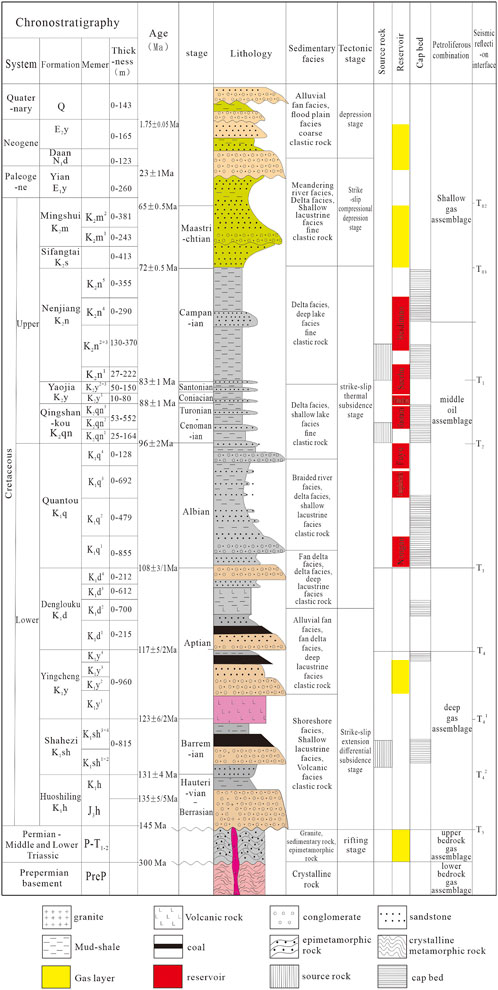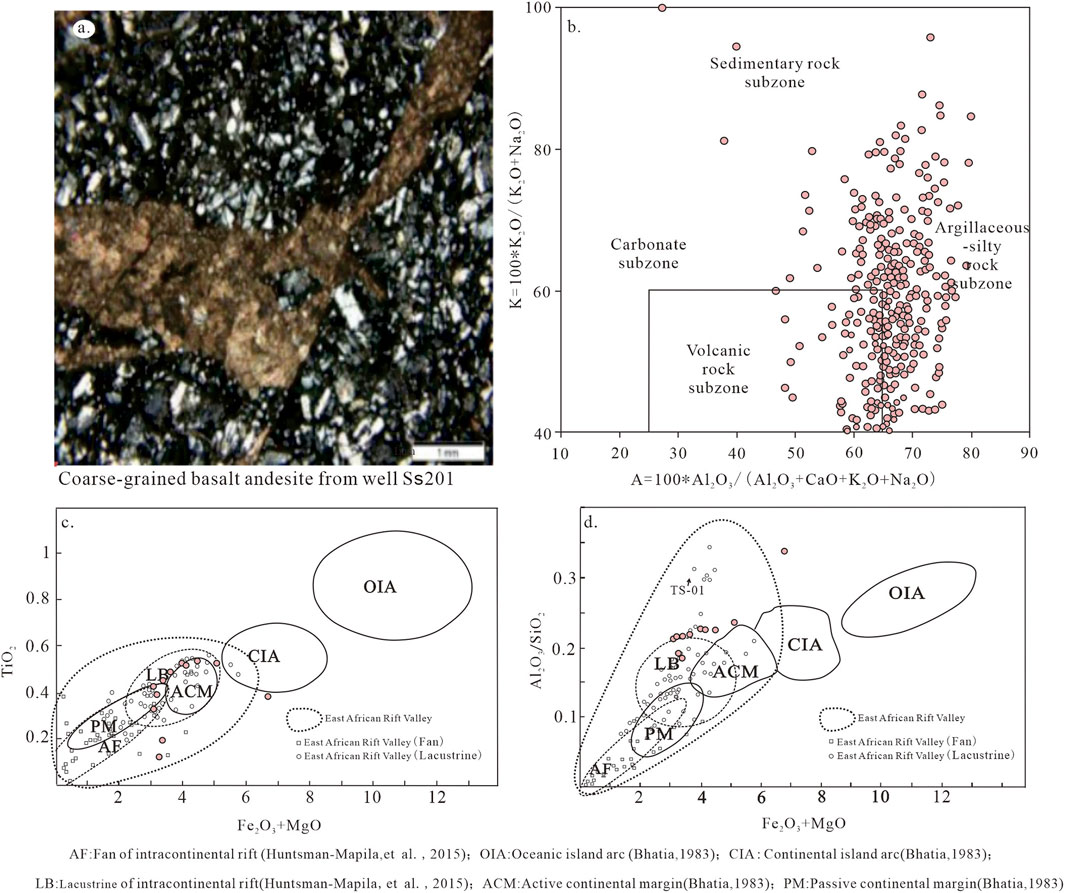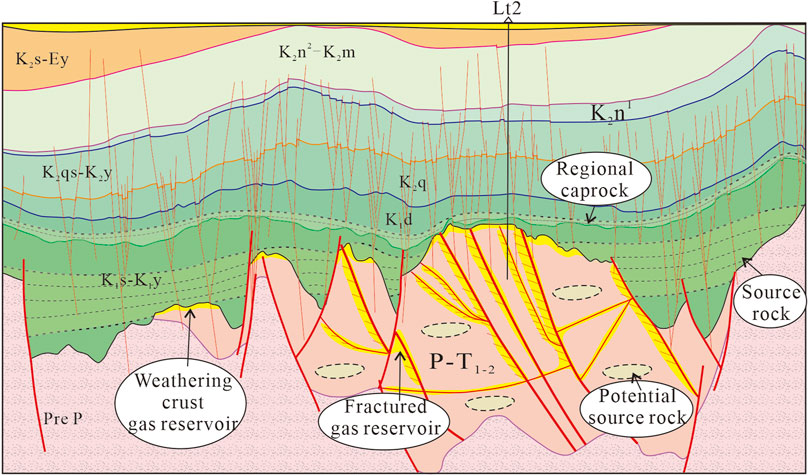- 1Xi’an Shiyou University, Xi’an, Shaanxi, China
- 2Chongqing University of Science and Technology, Chongqing, China
- 3Northeast Petroleum University, Daqing, Heilongjiang, China
Located on the Songnen block of the Northeast Asia block group, the Songliao Basin is sandwiched by three major plates in Siberia, North China, and the Pacific Ocean. The recognition of the basin's properties and the dynamic processes of formation, evolution, and late reformation of the Late Paleozoic–Early Mesozoic Basin (LP-EMB), which has suffered from intense multi-stage, and various types of late reformation, are always controversial. On the basis of previous research on the regional tectonic geological background, combined with petrochemical and chronological data from core samples and seismic data, the attributes, evolution process, and late reformation of the LP-EMB and its dynamic environments have been deeply analyzed. Since the Late Paleozoic, it has successively experienced the development of Late Hercynian to Early–Middle Indosinian rifts and subsequent multi-stage superimposed transformation stages, which can be divided into the near-north-trending thrust reformation in the Late Indosinian, the near-west-trending thrust reformation in the Early Yanshanian, the differential extensional reformation in the early Late Yanshanian, the strike-slip shearing and deep burial reformation in the middle Late Yanshanian, and the strike-slip compression fold transformation in the late Late Yanshanian to the early Himalayan. The formation of the LP-EMB was mainly controlled by back-arc extension caused by the subduction and retreat of the paleo-Pacific Plate and partly by the closure of the Paleo-Asian Ocean between the North China Plate and the Northeast Asia micro-block group. The later reformation stages were closely related to the collision extrusion, strike-slip activity, and deep mantle activity caused by either the relative convergence movement between Songnen and other micro-blocks in the Northeast China micro-block group or by the remote collision effect of the Northeast China micro-block group and the surrounding plates. The inner fault zone (body), which was formed by multi-phase fault cutting, and the top weathering and denudation unconformity surface, are potential sites of hydrocarbon accumulation, from which natural gas has been transported along the fault and fracture belt into the weathering crust and the inner fracture zone in the Upper Paleozoic–Lower Mesozoic (UP-LM). This study significantly expands our knowledge of the tectonic evolution and gas exploration of the Songliao Basin.
1 Introduction
The Songliao Basin, on the Songnen block in the middle of the Northeast Asia block group, is surrounded by the Siberia, North China, and Western Pacific plates (Figure 1). The pre-Paleozoic folded-crystalline basement of the basin was formed by the multi-phase collage of intra-ocean island arcs, or micro-block, which was rifted from the Siberian Plate or the subducting island arc in the Paleo–Asian Ocean through three collages: 1) the collage of early Caledonian combined with the Erguna and Xing’an blocks along the Xigutu suture zone in the early Early Paleozoic, 2) the collage of late Caledonian combined with the Songnen and Jiamusi–Xingkai blocks along the Mudanjiang suture in the pre-Devonian, and 3) the collage of late Hercynian combined with the Songnen and Erguna–Xing’an blocks along the Nenjiang suture in the late Early Carboniferous to early Late Carboniferous (Liu et al., 2019).
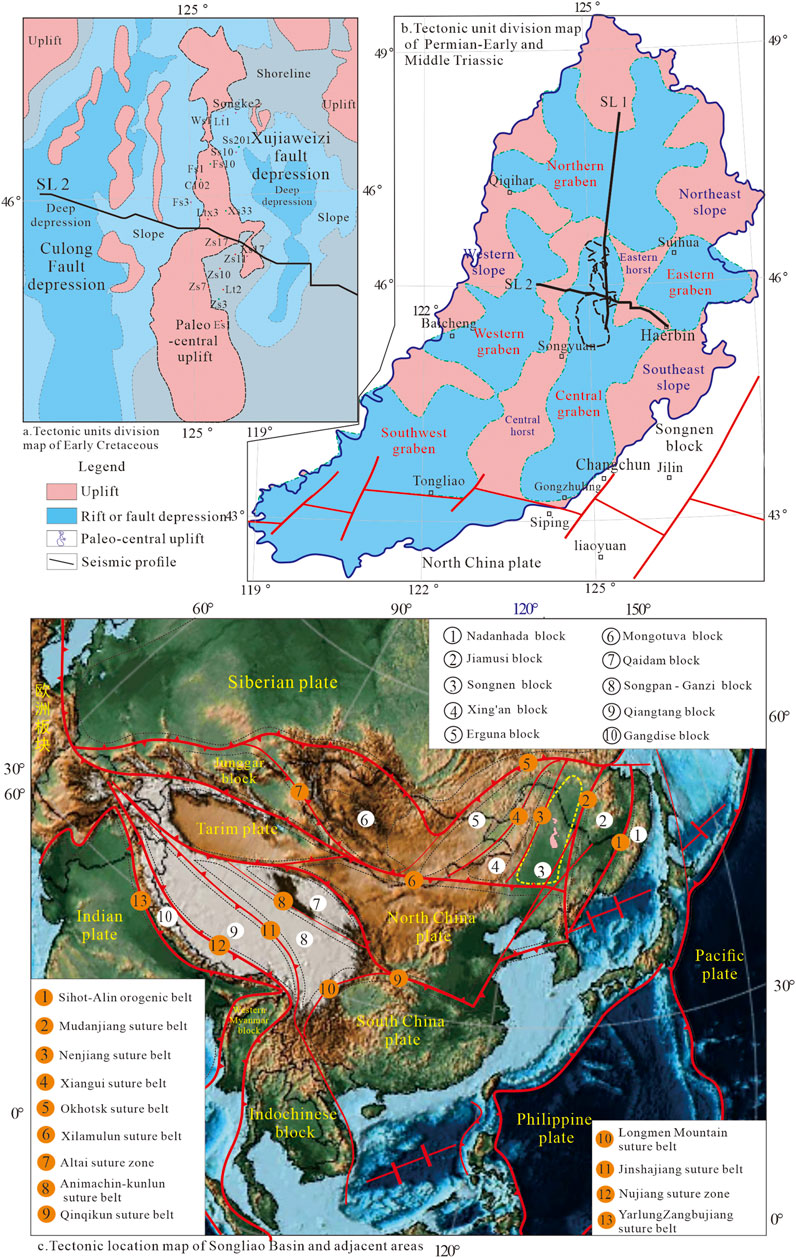
FIGURE 1. Structural characteristics and tectonic setting of Songliao Basin. Paleogeographic maps modified from Scotese (2016).
The present Songliao Basin is mainly composed of the middle to lower parts of the Lower Cretaceous rifted strata, the upper part of the Lower Cretaceous to Upper Cretaceous depression strata and the Cenozoic depression strata (Figure 2). Among them, the Lower Cretaceous rifted strata are composed of the Huoshiling Formation (K1h), the Shahezi Formation (K1sh), the Yingcheng Formation (K1y), and the Denglouku Formation (K1d), which were unconformably covered by the Lower Cretaceous Quantou Formation (K1q), the Upper Cretaceous Qingshankou Formation (K2q), the Yaojia Formation (K2y), the Nenjiang Formation (K2n) and the Sifangtai Formation (K2s). The Mingshui Formation (K2m) and the Cenozoic depression strata, composed of Paleogene, Neogene and Quaternary, are unconformably overlaid on the underlying strata (Figure 2) (Di, 2013; Du, 2017).
Between the Cretaceous strata and the basement, it is a set of Upper Paleozoic–Lower Mesozoic (UP-LM) sedimentary strata of the Songliao Basin (Figures 2, 3). The precise age (Huang et al., 2019), lithological composition (Chen, 2016; Guo et al., 2019; Zhang et al., 2020), structural characteristics (Zhang, 2006; Wang, 2016; Du, 2017), evolution process (Liu et al., 2003; Zhang et al., 2006), reservoir characteristics (Chen, 2016; Du, 2017; Guo et al., 2019), and hydrocarbon accumulation laws (Du, 2017; Zhang et al., 2019) have been discussed in previous studies. It has been shown that the rock series, composed of metamorphic sandstone, marble, slate, and phyllite, have developed multiple sets of thrust faults in different directions among them, through long-term weathering and denudation, thermal metamorphism, dynamic metamorphism, and other late transformations since the Late Paleozoic (Wu et al., 2000; Chen, 2016). There remain differing opinions on the formation age, formation evolution, and later transformation of this set of rock series due to the lack of a systematic understanding of the process and its dynamic environment, which restricts in-depth promotion of petroleum exploration and development.
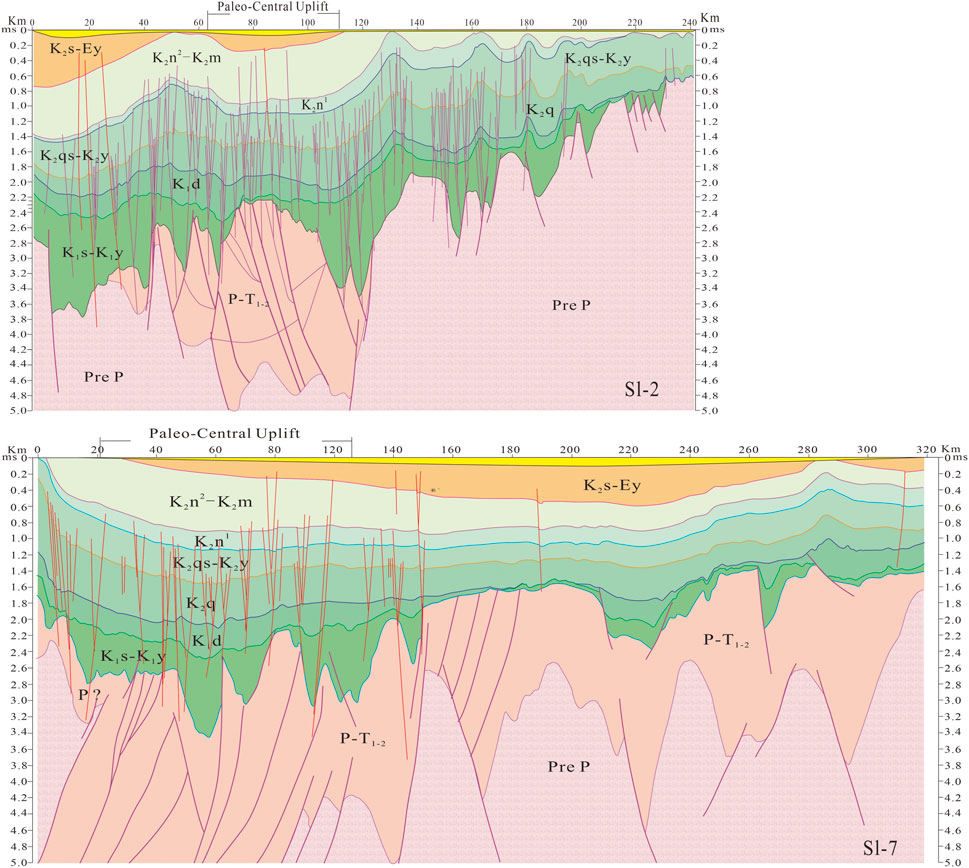
FIGURE 3. Structural profile of SL-1 and SL-2 in Songliao Basin (locations of the section are shown in Figure 1).
In analyses of the formation time of the LP-EMB and its basin properties, formation, evolution and reformation processes, the dynamic environment and hydrocarbon accumulation conditions are of greatly significant in enriching the theoretical understanding and improving the scientific guidance of petroleum exploration. They can also be used as references for petroleum exploration in other Upper Paleozoic basins and superimposed reformation basins in China (Guo et al., 2021; Fang et al., 2021; Niu et al., 2021).
2 Materials and methods
The data involved in this study include 2D/3D seismic data, well loggings, and borehole core analysis test data such as geochemical, chronological, and thin-section identification data. In addition, numerous previous research results have been collected and used in this study, especially recent regional geological survey results (Zhou et al., 2018; Liu et al., 2019; Wang et al., 2021), oil field deep drilling data (Du, 2017; Guo et al., 2019; Hou et al., 2018; Huang et al., 2019a; Huang et al., 2019b) and regional geological background research results (Maruyama and Seno, 1986; Maruyama, 1997; Han et al., 2015).
To understand the basin properties, the processes of formation, evolution and late reformation and the hydrocarbon conditions of the LP-EMB, we comprehensively interpreted seismic data, analyzed structural evolution based on the equilibrium profiles of L1 and L2, analyzed the dynamic process of basin formation, evolution and late reformation and combined these with previous research results.
To highlight the accuracy and rationality of the understandings, we integrate the data from different sources and scales into the same figures to emphasize the coupling relationship between the basin’s evolution and late reformation, as well as its deep and regional structures. Therefore, a comprehensive analysis was generally used in this study.
3 Formation and evolution
3.1 Deposition age
Drilling on the paleo-central uplift of the Songliao Basin has revealed that the UPLM lithology is complex, composed of sedimentary rocks, metamorphic rocks and syntectonic magmatic rocks. It is mainly composed of volcanic rocks or volcaniclastic rocks, as evidenced by the deposition of rhyolite and andesite revealed in the cores of wells Ss 10, Fs 3, Xs 17, Xushen 33, and Ss 201, and the location of volcanic rock areas in an A-K original rock lithology discrimination map of schist samples from wells Lt 1 and Lt X3 (Figure 1).
It was mainly composed of volcaniclastic rocks (Figures 4A, B) from the Permian to the middle Triassic, developed in the strongly volcanic activity of the late period of the Late Hercynian to the middle Indosinian period, as evidenced by the range of chronological data (from 308 to 245Ma, peak at 270 Ma) from volcanic rock samples of wells Lt 1, Ss 10, Ws 2, Ss 201, Fs 10, Lt X3, and Zs 3; the two Permian volcanic events erupted at 282.5 ± 2.8 Ma and 255.4 ± 2.6 Ma, as evident from andesite samples from well Ss 10 (Huang et al., 2019). In addition, volcanic rocks (264 ± 3Ma, 287 ± 5Ma, 274 ± 3Ma, Ding et al., 2007), intrusive rocks (305 ± 2Ma), granodiorite (well DuI-4, Wu et al., 2011), and quartz diorite (236 ± 3Ma, well T6- 1, Gao et al., 2007) have also been found in the periphery of the paleocentral uplift of the Songliao Basin.
The Nenjiang Ocean, between the Songnen and Erguna–Xing’an blocks, was closed in the late Early Carboniferous and the early Late Carboniferous (Liu et al., 2019). In the western margin of the Songliao Basin, Permian in outcrops is unconformable over Carboniferous (Li, 2019). Therefore, the set of rock series should be reasonably assumed to have been deposited during the Late Paleozoic to Early Mesozoic.
3.2 Basin properties, formation, and evolution
3.2.1 Back-arc extensional rifting stage
The distribution of UPLM volcanic-bearing clastic rocks is controlled by normal faults, mainly in the nearly north–south rift trough (Figures 3, 5A, 6A). A discriminant map of the geochemical tectonic environment of TiO2-(Fe2O3+MgO) and Al2O3/SiO2-(Fe2O3+MgO) (Bhatia, 1983) shows the characteristics of the continental region and rift environment, which are similar to the East African Rift (Huntsman-Mapila et al., 2009) (Figures 4C, D). It indicates that the Mudanjiang Ocean was reopened on the east side of the Songnen block in the Permian, as evidenced by the intrusion age (251 ± 1 Ma) of metamorphic gabbro samples and the eruption age (252 ± 1 Ma) of metamorphic pillow-like basalt samples, with the characteristics of paleo-oceanic crust fragments, in the Mudanjiang ophiolite melangite belt in Pingan Village, Yilan County (Liu et al., 2019). The paleo-Pacific Ocean crust on the east side of the Jiamusi Block began to subduct during the late Carboniferous, as evidenced by the Zhenzishan Formation deposited in the continental margin sedimentary environment in the Upper Carboniferous (Liu et al., 2019). In addition, the Songnen block drifted rapidly from west to east during the Late Paleozoic (Scotese, 2016).
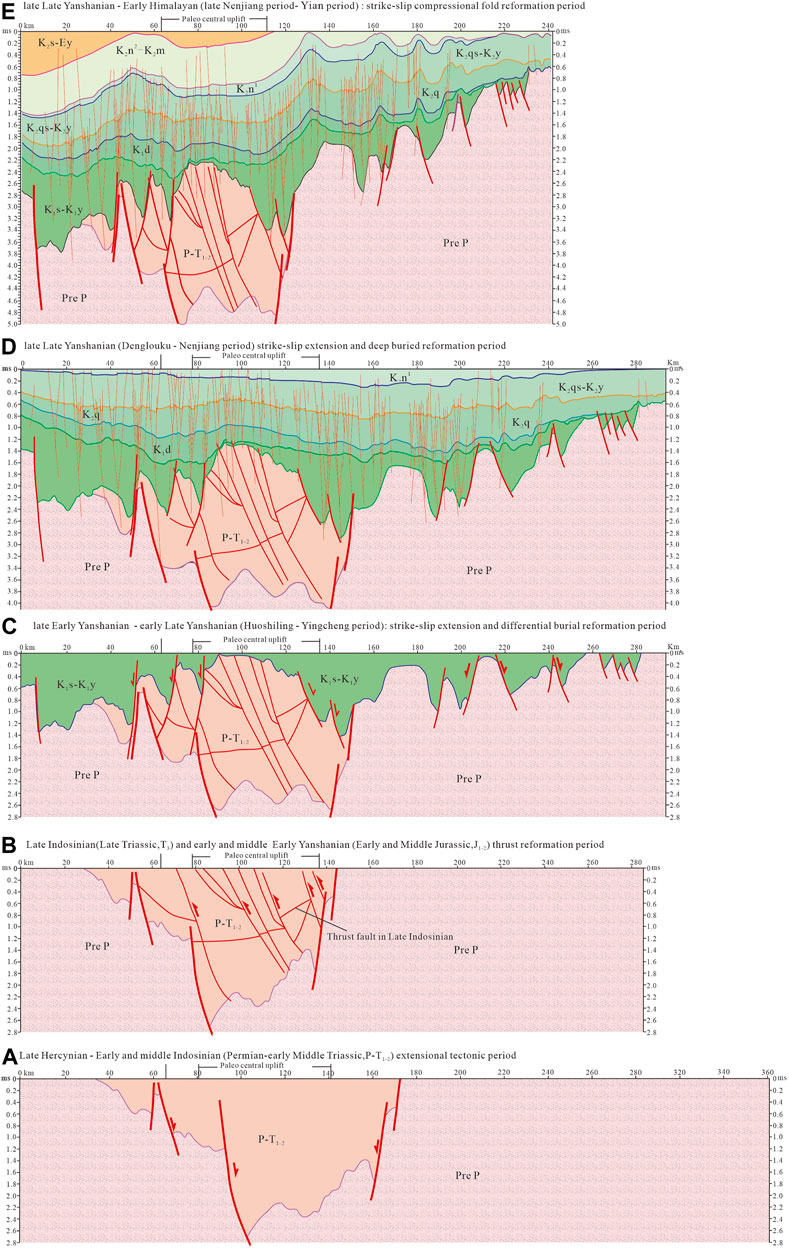
FIGURE 5. Structural evolution of east–west section of SL2 in Songliao Basin (location of the section is shown in Figure 1).
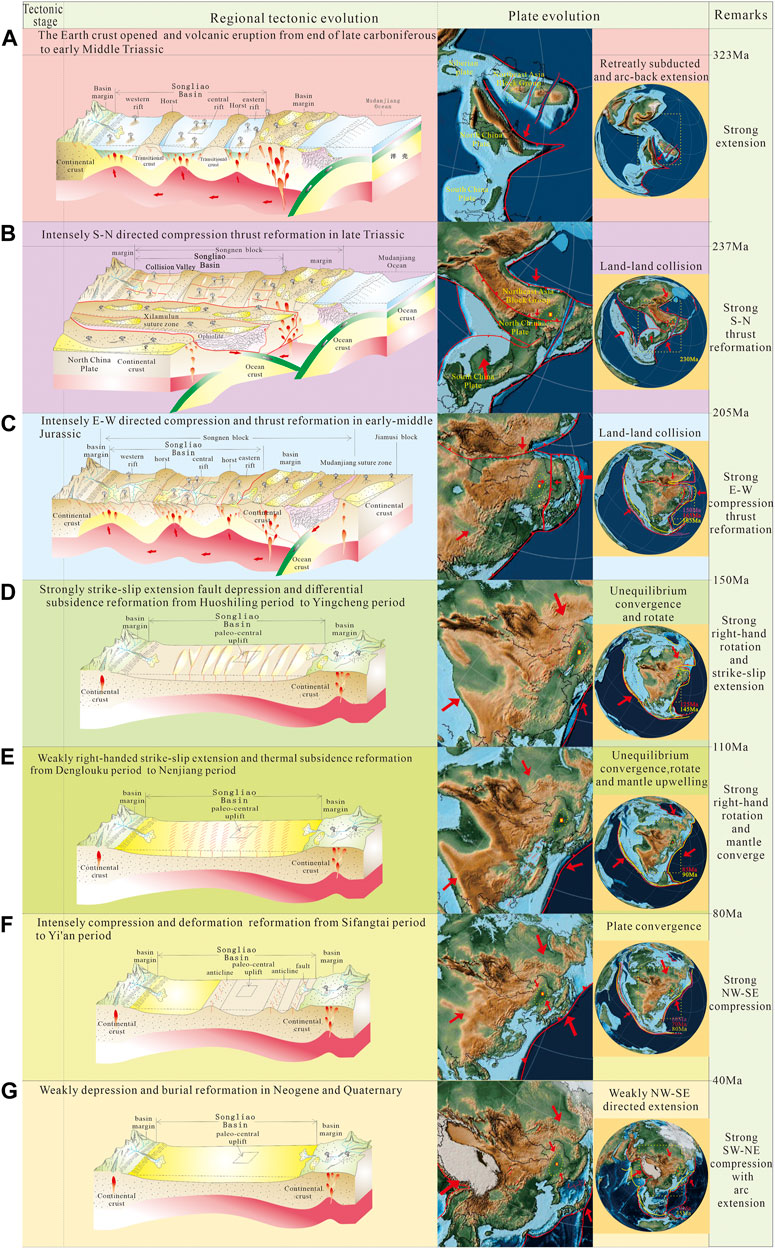
FIGURE 6. Schematic diagram of dynamic background of formation, evolution, and later transformation of Songliao Basin. Paleogeographic maps modified from Scotese (2016).
The aforementioned evidence indicates that the Mudanjiang Ocean was reopened under a back-arc extension background caused by the rapid subduction and retraction of the Paleo-Pacific plate. Therefore, the Songnen block and its adjacent areas were also rifting under the back-arc extension background starting in the late Hercynian and possibly lasting until the middle Indosinian (Figure 6A).
3.2.2 Collision rift stage
The Xilamulun suture zone began to close in the late Permian to Early–Middle Triassic (Wang et al., 2016) and began to provide provenance for the Linxi Formation in the Linxi area, as evidenced by the Permian pillow lava in the ophiolite (∼260 Ma, Miao et al., 2007); the Permian Radiolaria in the semi-deep-sea or deep-sea siliceous rocks of the ophiolite belt in Linxi County (Wang and Fan, 1997); the syn-collision granite in Dayushan, Jilin Province (248 Ma, Sun et al., 2004); and the Early Mesozoic detrital zircon composition in the Linxi Formation sandstones in eastern Inner Mongolia (238 Ma, Han et al., 2015; 249∼233 Ma, Wang et al., 2021).
The aforementioned evidence reveals that the east–west crustal extension rifting events in the Songnen block and the surrounding areas may have been partly influenced by the collision of the North China Plate and the Northeast Asia block group (Figures 5B, 6B) and was in a collisional rifting stage in the Early and Middle Triassic.
3.2.3 Tectonic evolution
Under the back-arc east–west direction extension caused by the subduction of the Paleo-Pacific plate, the crust was extending east to west; rifts were developing in the Northeast Asia block group in the Permian and were filled with volcaniclastics from 308 Ma to 245 Ma (peak at 270Ma) (Figures 2, 4–6).
From the end of the Late Permian to the Early-to-Middle Triassic, the Songliao Basin entered the stage of collision rift caused by north–south extrusion as the North China Plate collided with the Northeast Asia block group. The Middle Triassic andesite (242.6 ± 0.77 Ma, Hou et al., 2018) drilled from the core of well Songke II also supports the volcanic rift events in this period.
4 Late basin reformations
Since the late Triassic, the LP-EMB has experienced complex late tectonic evolution, in which different interwoven properties and occurrence faults developed in the UP-LM (Figures 3, 5, 6). Among these, the inner east–west thrust faults and the near north–south thrust faults successively developed, followed by the negative flower strike-slip faults developed and controlled by the former and lower fault.
4.1 Extrusion thrust reformation
4.1.1 North–south-directed thrust transformation in the late Indosinian
South-dipping thrust faults developed in the UP-LM (Figure 3). In the Late Triassic, the southern margin of the Songnen block was strongly squeezed by the south–north-directed continental collision of the North China Plate and the Northeast Asian block group, as proved by evidence such as the metamorphic events of the Changchun–Panshi–Huadian–Kaishantun metamorphic complex in the eastern section of the Xilamulun suture zone (230 Ma, Zhou et al., 2019), the presence of Late Triassic granite intrusion in the central Jilin Province (216 ± 3 Ma, Sun et al., 2005) and the distribution of the Indosinian S-type granitic zone in the northern margin of the North China Plate (Xie, 2016).
The aforementioned evidence indicates that in the Late Indosinian, under the tectonic background of north–south-directed continent-continental compressional collision caused by the closure of the paleo-Asian Ocean along the Xilamulun suture (Figure 6B), the UP-LM experienced extrusion and thrust transformation from south to north, with the development of south-dipping imbrachial fan-type thrust faults (Figures 3, 5B) and magmatic intrusion in the late Triassic, such as the late Indosinian granite from wells Zs 11 (214 Ma) and Zs 10 (224 Ma).
4.1.2 East–west-directed thrust transformation in the early Yanshanian
East-dipping thrust faults developed in the UP-LM (Figure 3) and indicate that the collision between the Jiamusi and Songnen blocks occurred in the early Yanshanian, as evidenced by the formation of ophiolite melange in the Heilongjiang Group between the Jiamusi and Songnen blocks in the early Jurassic (Wu et al., 2007); the metamorphic age of its internal structural melange was from 165 to 180 Ma in the Jurassic (Wu et al., 2004).
Numerous Jurassic granites intruded into the central Jilin Province and the Zhangguangcai rise (Sun et al., 2005; Wu et al., 2007) and the Jurassic granites (192–168 Ma, Zhang et al., 2004) in Yanbian County, on the eastern margin of the Songnen block, should be considered the result of this subduction collision.
The aforementioned evidence indicates that in the Early-to-Middle Jurassic, under the tectonic background of the compressional collision between the Jiamusi and Songnen blocks along the Mudanjiang suture (Figure 6C), east-dipping thrust-napper structures were developed in the UP-LM due to the intense east–west-directed tectonic compression (Figures 3, 5B). At the same time, the early Yanshanian granitic magmas intruded into the UP-LM, resulting in the hydrothermal transformation of these rift systems. Therefore, wells such as Zs 3 (170 Ma), Zs 7 (170 Ma), C403 (172 Ma), and Fs 901 (180 Ma) were drilled into early Yanshanian granite.
4.2 Difference in burial transformation
The Northeast Asia block group migrated northward (Hou et al., 2009) from the Early Cretaceous Huoshiling period through the Denglouku period (Lin et al., 2003), and multiple rifts (such as the Xujiaweizi and Gulong fault depressions) experienced multiphase rifting under the influence of right-handed strike-slip extension in Northeast Asia (Lin et al., 2003). Meanwhile, the Nujiang Ocean between the Gangdise and Qiangtang blocks was closed (Scotese, 2016).
These findings indicate that the influence of right-lateral strike-slip extension led to the closure of Nujiang Ocean, the extension of the near-SN fault formed in the former stage, and subsequently, the UP-LM undergoing differential rise or burial transformation. With the rapid subsidence of the Xujiaweizi and Gulong fault depressions, the paleocentral uplift in the Songliao Basin rose rapidly (Figures 3, 5C, 6D), accompanied by mantle upwelling and volcanic eruption.
Intermediate acid rhyolite volcanic rocks (108–116 Ma, peak 111–113 Ma) in the Xujiaweizi fault depression recorded the dextral strike-slip extensional rifting event (Zhang, 2007).
4.3 Shear-deep burial transformation
The time between the Early Cretaceous Qingshankou period and the Nenjiang Period was characterized by plastic crustal thinning, volcanic eruption, intense thermal subsidence, and the extensive development of a small, negative flower-like normal fault system in Songliao Basin (Figures 3, 5D). At the same time, it was occurred the closure of the Nujiang Ocean, the closure of the Mongolian–Okhotsk Sea, the southwest-directed subduction of the Plaeo-pacific Plate (Izanagi plate) (Figure 6, Maruyama, 1997; Maruyama, 1997), and the clockwise rotation of the Northeast Asia block group, which drifted rapidly to the south (Hou et al., 2009).
The aforementioned evidence indicates that strong subsidence with right-lateral strike-slip shearing, under the tectonic background of dextral strike-slip and mantle convergence upwelling, caused the closure of the Nujiang Ocean, the closure of the Mongolian–Okhotsk Sea and the southwest-directed subduction of the Plaeo-pacific Plate(Izanagi plate) (Figure 6E).
As a result, the UP-LM was covered by the super-thick strata of the second member the Denglouku Formation and it’s overlying layer and suffered a certain dextral strike-slip shear transformation (Figures 3, 5). The volcanic rocks of the Nenjiang Formation in well Songke 2 (83.35 ± 0.11 Ma, 83.498 ± 0.052 Ma, Hou et al., 2018) recorded this tectonic-thermal event.
4.4 Strong squeeze reformation
From the late Nenjiang Period to the Mingshui period of the Late Cretaceous, the depositional center of the lake basin moved westward and gradually shrank (Song, 2010). Finally, a series of NE-trending folds and NW-trending small normal fault systems was formed, including the Daqing placanticline (Huang et al., 2019).
In the meantime, the Siberia plate was drifting southward and colliding with the Northeast Asia block group, and the Mongolia–Okhotsk sea trough was eventually closed (Scotese, 2016), while the Pacific-Izanagi plate was subducting nearly westward and retreating south-eastward (Scotese, 2016) (Figure 6F).
The aforementioned evidence indicates strong sinistral strike-slip shear-extrusion from the end of the Yanshanian to the Early Himalayan (Figures 3, 5E), caused by NWW-SEE-directed compressional convergence between the Siberia plate and the Northeast China block group along the Mongolia–Okhotsk suture.
The aforementioned evidence demonstrates that, under the tectonic background of NWW-SEE-directed sinistral compression mainly driven by the Siberia plate drifting southward and colliding with the Northeast Asia block group, the UP-LM was transformed by shear-extrusion from the end of the Yanshanian through the early Himalayan, and a series of NNE-trending folds was formed in the overlying strata (Figures 3, 5). Afterward, the Songliao Basin was formed, and only a molasse formation with a thickness of less than 150 m was deposited on the underlying eroded unconformity in the Late Himalayan (Figure 3).
5 Significance of petroleum exploration
Potential source rocks were developed in the Upper Paleozoic to Early Mesozoic rifted strata, with TOCs ranging from 0.017% to 0.198% (Zhang et al., 2019). In addition, dark argillaceous source rocks of the Shahezi Formation were widely distributed across the Early Cretaceous fault depression (Pei, 2008). The methane gas reservoir in the UP-LM is mainly from the Shahezi Formation (94.71%) (Zhang et al., 2008), whose carbon isotope distribution of methane in natural gas (−31‰∼−23.9‰) is essentially consistent with that in the dark mudstone adsorption gas of the Shahezi Formation (−30.2‰∼−24.8‰) (Li et al., 2006; Wang et al., 2014).
The UP-LM was affected by multi-stage thrust and multi-stage shear, so that the dense fractures developed along the fracture plane formed the inner fracture zone or fracture body. The oil and gas generated in potential hydrocarbon source rocks in the UP-LM and in the source rock of the Shahezi Formation migrated along the inside fracture and fracture belt into the top-weathering crust trap and the inside fracture zone, or fracture belt trap, to form gas reservoirs under the mudstone seal of the second segment of the Lower Cretaceous Denglouku Formation (Figure 7). The gas measurement results of multiple internal fracture sections in wells Lt 1, Lt 2, and Ch102 are good, which fully proves that the internal fracture gas reservoir has important exploration potential.
6 Conclusion
The formation, evolution, and late transformation processes of the UP-LM and its petroleum accumulation are discussed. The complex splice process between the Songnen block and other blocks or plates resulted in multi-period magmatic activity and superimposed transformation of metamorphic deformation in the UP-LM of the Songliao Basin.
The rifts developed in the Songliao Basin from the Permian through the Middle Triassic are filled with pyroclastic rock series. Therein, the back-arc extension rifts developed in the Late Hercynian belong to the west-dipping subduction and retreat of the Paleo-Pacific plate along the Siholt–Arin suture belt; subsequently, the rifts continued to develop in the Early and Middle Indosinian causedby the north–south- directed convergence collage of the North China Plate and the Northeast Asia block group along the Xilamulun suture zone. Since then, the UP-LM has experienced multiple intense transformations: the late Indosinian north–south-directed compressional thrust transformation causing the closure of the Paleo-Asian Ocean; the Early Yanshanian east–west-directed compressive thrust transformation caused by the closure of Mudanjiang Ocean; the shear differential burial transformation in the early Late Yanshanian and, subsequently, the shear-deep burial transformation in the late Late Yanshanian causing the closure of the Nujiang Ocean between the Gangdise and Qiangtang blocks; and the compression-shear transformation primarily originating from the closure of the Sea of Okhotsk from the end of the Yanshanian through the Early Himalayan.
The multiple groups of faults and fractures developed in the UP-LM through multi-stage thrust and shear transformation. The natural gas migrated from the inner stratum and source rock of the Shahezi Formation along the unconformity plane and fault plane to the top-weathering crust gas reservoirs and internal fracture gas reservoirs. The weathering crust reservoir and inner fracture reservoir at the intersection of multiple fault groups are favorable targets for petroleum accumulation.
Data availability statement
The original contributions presented in the study are included in the article/Supplementary Material; further inquiries can be directed to the corresponding authors.
Author contributions
LS, YS, and FX wrote the paper, YR completed the paper map, and JL and YY collected and collated paper data.
Funding
This study was supported by the Natural Science Foundation of China (No. 41102072) and the China Geological Survey Project (No. DD20160227).
Conflict of interest
The authors declare that the research was conducted in the absence of any commercial or financial relationships that could be construed as a potential conflict of interest.
Publisher’s note
All claims expressed in this article are solely those of the authors and do not necessarily represent those of their affiliated organizations, or those of the publisher, the editors, and the reviewers. Any product that may be evaluated in this article, or claim that may be made by its manufacturer, is not guaranteed or endorsed by the publisher.
References
Bhatia, M. R. (1983). Plate tectonics and geochemical composition of sandstones. J. Geol. 91 (6), 611–627. doi:10.1086/628815
Chen, J. (2016). The study of bedrock characteristics and advantages of reservoir of central paleouplift in northern Songliao Basin. Thesis. China: A Dissertation Submitted to China University of Geosciences for Master Degree.
Di, J. X. (2013). Characteristics analysisof Paleocentral Uplift belt of North Songliao baisn natural gas reservior. Inner Mongolia petrochemical Industry (2), 151–152
Ding, R. X., Shu, P., Ji, X. Y., Qu, Y. M., Cheng, R. H., and Zhang, B. (2007). SHRIMP zircon U-Pb age and geological meaning of reservoir volcanic rocks in Qingshen gas fifield of the Songliao basin, NE China. J. Jilin Univ. (Earth Sci.) 37, 525–530. doi:10.13278/j.cnki.jjuese.2007.03.017
Du, J. (2017). Analysis of natural gas accumulation conditions and exploration perspective in the central paleo-uplift belt (north), Songliao Basin. China Pet. Explor. 22 (5), 1–14. doi:10.3969/j.issn.1672-7703.2017.05.001
Fang, C., Liang, Y., and Yan, X. (2021). Guiding and method for division of petroleum exploration play in superimposed reformation basin. Petroleum Geol. Exp. 43 (6), 1078–1088. doi:10.11781/sysydz2021061078
Gao, F. H., Xu, W. L., Yang, D. B., Pei, F. P., Liu, X. M., and Hu, Z. C. (2007). LA-ICP-MS zircon U-Pb dating from granitoids in southern basement of Songliao basin: Constraints on ages of the basin basement. Sci. China (D) 50, 995–1004. doi:10.1007/s11430-007-0019-7
Guo, J., Shan, X., and Hao, G. (2019). Identification of basement lithology in central uplift zone of Songliao Basin by Fisher discriminant analysis. J. Heilongjiang Univ. Sci. &Technology 29 (1), 60–65. doi:10.3969/j.issn.2095-7262.2019.01.011
Guo, S., Wang, Z., and Ma, X. (2021). Exploration prospect of shale gas with Permian transitional facies of some key areas in China. Petroleum Geol. Exp. 43 (3), 377–385. doi:10.11781/sysydz202103377
Han, J., Zhou, J., Wang, B., and Cao, J. (2015). The final collision of the CAOB: Constraint from the zircon U-Pb dating of the Linxi Formation,Inner Mongolia. Geosci. Front. 6 (2), 211–225. doi:10.1016/j.gsf.2014.06.003
Hou, H., Wang, C., Zhang, J., Ma, F., Fu, W., Wang, P., et al. (2018). Deep continental scientific drilling engineering in Songliao Basin: Resource discovery and progress in Earth science research. Geol. China 45 (4), 641–657. doi:10.31035/cg2018036
Hou, Q., Feng, Z., and Feng, Z. (2009). Continental petroleum geology in Songliao basi. Beijing: Petroleum Industry Press, 70.
Huang, L., Tong, H., Yang, D., Fan, J., and Huang, H. (2019b). A new model for the formation and evolution of middle-shallow faults in the Daqing placanticline,Songliao Basin. Acta Geol. Sin. 93 (3), 597–605. doi:10.19762/j.cnki.dizhixuebao.2019040
Huang, Q., Zhu, G., Wang, H., and Cheng, H. (2019a). Zircon U-Pb age of the basement rocks and its geological significances in paleo- central uplift belt of Songliao Basin. Petroleum Geol. Oilfield Dev. Daqing 38 (3), 1–7. doi:10.19597/J.ISSN.1000-3754.201811055
Huntsman-Mapila, P., Tiercelin, J. J., Benoit, M., Ringrose, S., Diskin, S., and CottenHémond, J. C. (2009). Sediment geochemistry and tectonic setting: Application of discrimination diagrams to early stages of intracontinental rift evolution, with examples from the okavango and southern tanganyika rift basins. J. Afr. Earth Sci. 53 (12), 33–44. doi:10.1016/j.jafrearsci.2008.07.005
Li, J., Liu, W., and Song, L. (2006). A study of hydrocarbon generation conditions of deep source rocks in Xujiaweizi fault depression of the Songliao Basin. Nat. Gas. Ind. 26 (6), 21–24.
Li, J. Y. (2006). Permian geodynamic setting of northeast China and adjacent regions: Closure of the paleo-Asian ocean and subduction of the paleo-Pacific plate. J. Asian Earth Sci. 26 (3-4), 207–224. doi:10.1016/j.jseaes.2005.09.001
Lin, W., Chen, Y., Faure, M., and Wang, Q. C. (2003). Tectonic implications of new late cretaceous paleomagnetic constraints from eastern liaoning peninsula, NE China. J. Geophys. Research-Solid Earth 108 (B6), 1–17. doi:10.1029/2002jb002169
Liu, X., Meng, L., Huang, C., and Zhao, C. (2003). GIS-based reconstruction of basin paleotectonics: An example from paleo-central uplift belt, northern Songliao Basin. Earth Science— J. China Univ. Geosciences 28 (3), 346–350.
Liu, Y. J., Feng, Z. Q., Jiang, L. W., Jin, W., Li, W. M., Guan, Q. B., et al. (2019). Ophiolite in the eastern central asian orogenic belt,NE China. Acta Petrol. Sin. 35 (10), 3017–3047. doi:10.18654/1000-0569/2019.10.05
Maruyama, S. (1997). Pacific-type orogeny revisited: Miyashiro-type orogeny proposed. Isl. Arc 6, 91–120. doi:10.1111/j.1440-1738.1997.tb00042.x
Maruyama, S., and Seno, T. (1986). Orogeny and relative plate motions: Example of the Japanese islands. Tectonophysics 127, 305–329. doi:10.1016/0040-1951(86)90067-3
Miao, L. C., Liu, D. Y., Zhang, F. Q., Fan, W. M., Shi, Y. R., and Xie, H. Q. (2007). Zircon shrimp U-Pb ages of the “xinghuadukou group” in hanjiayuanzi and xinlin areas and the “zhalantun Group”in inner Mongolia, da hinggan mountains. Chin. Sci. Bull. 52 (8), 1112–1124. doi:10.1007/s11434-007-0131-2
Niu, C., Wang, F., He, J., and Tang, G. (2021). Accumulation factor matching and model of Bozhong 19-6 buried hill gas reservoir, Bohai Sea area. Petroleum Geol. Exp. 43 (2), 259–267. doi:10.11781/sysydz202102259
Pei, M. (2008). Study on sequence stratigraphy of deep order of paleo-central uplift belt. Thesis. Daqing: A Dissertation submitted to Daqing Pettoleum Institute For the Academic Degree of Master of Science.
Scotese, C. R. (2016). Paleomap PaleoAtlas for GPlates and the PaleoData plotter program, paleomap Project. Avaliable At: http://www.earthbyte.org/paleomappaleoatlas-for-gplates/.
Song, Y. (2010). The post-rift tectonic inversion of Songliao Basin,NE China and its dynamic background. Thesis. Wuhan: A Dissertation Submitted to China University of Geosciences for the Doctor Degree of Philosophy.
Sun, D., Wu, F., Gao, S., and Lu, X. (2005). Confirmation of two episodes of A-type granite emplacement during late triassic and early jurassic in the central Jilin Province, and their constraints on the structural pattern of eastern jilin-heilongjiang area, China. Earth Sci. Front. 12 (2), 263–275.
Sun, D., Wu, F., Zhang, Y., and Gao, S. (2004). The final closing time of the west Lamulun River -Changchun -Yanji plate suture zone Evidence from the Day ushan granitic pluton, Jilin Province. J. Jilin Univ. Earth Sci. Ed. 34 (2), 174–181.
Wang, D., Li, S., Zhou, X., Liu, W., Lin, Y., Zeng, Q., et al. (2016). Shrimp U-Pb dating of detrital zircon from the upper permian Linxi Formation in eastern inner Mongolia,and its geological significance. Geol. Rev. 62 (4), 1021–1040. doi:10.16509/j.georeview.2016.04.018
Wang, J. (2016). Study on the basement structure characteristics of the paleo-central uplift belt. Thesis. Daqing: A Dissertation submitted to Daqing Pettoleum Institute For the Academic Degree of Master of Science.
Wang, M., Sun, Y., Wang, W., Wang, Y., and Shi, L. (2014). Gas generation characteristics and resource potential of the deep source rock in Xujiaweizi fault depression, northern Songliao Basin. Nat. Gas. Geosci. 25 (7), 1011–1018. doi:10.11764/j.issn.1672-1926.2014.07.1011
Wang, X., Ren, Y. S., Zhang, Y., and Zhao, D. S. (2021). Sedimentary response to the non-synchronous closure of paleo-Asian ocean: Evidence from U-Pb ages and Hf isotopic compositions of detrital zircons from the Linxi Formation, NE China. Int. Geol. Rev. 63 (2), 144–160. doi:10.1080/00206814.2019.1706650
Wang, Y., and Fan, Z. (1997). Discovery of permian radiolarians in ophiolite belt on northern side of xarmoron river, neimonggol and its geological significance. Acta Palaeontol. Sin. 36 (1), 5869.
Wu, F. Y., Sun, D. Y., Ge, W. C., Zhang, Y. B., Grant, M. L., Wilde, S. A., et al. (2011). Geochronology of the Phanerozoic granitoids in northeastern China. J. Asian Earth Sci. 41 (1), 1–30. doi:10.1016/j.jseaes.2010.11.014
Wu, F. Y., Sun, D. Y., Jahn, B. M., and Wilde, S. A. (2004). A Jurassic garnet-bearing granitic pluton from NE China showing tetrad REE patterns. J. Asian Earth Sci. 23, 731–744. doi:10.1016/s1367-9120(03)00149-4
Wu, F. Y., Sun, D. Y., Li, H. M., and Wang, X. (2000). Zircon U-Pb ages of the basement rocks beneath the Songliao Basin, NE China. Chin. Sci. Bull. 45 (16), 1514–1518. doi:10.1007/bf02898900
Wu, F. Y., Yang, J. H., Lo, C. H., Wilde, S. A., Sun, D. Y., and Jahn, B. M. (2007). The Heilongjiang group: A jurassic accretionary complex in the Jiamusi massif at the Western pacific margin of northeastern China. Isl. Arc 16 (1), 156–172. doi:10.1111/j.1440-1738.2007.00564.x
Xie, K. (2016). Petrogenesis of early late jurassic rhyolite from zhirui basin in southern great xing’an range: Constraints from chronology and geochemistry. Thesis. Nanchang: Dissertation for master’s degree of East China University of technology.
Zhang, F., Chen, H., Dong, C., Yu, X., Xiao, J., Pang, Y., et al. (2008). Evidence for the existence of precambrian basement under the northern Songliao basin. Geol. China 35 (3), 421–428.
Zhang, F. (2007). Early cretaceous volcanic event in the northern Songliao Basin and its geodynamics. Thesis. Hangzhou: A Dissertation submitted to Zhejiang University for the Academic Degree of Doctor of Science.
Zhang, F., Ran, Q., Wu, Y., and Ren, Z. (2019). Geochemical characteristics and reservoir forming conditions of the natural gas in the paleo central uplift zone in the northern Songliao Basin. Nat. Gas. Geosci. 30 (1), 126–132. doi:10.11764/j.issn.1672-1926.2018.10.002
Zhang, M., Zhang, Y., and Nian, X. (2006). Deep-seated structural characteristic and evolution of paleo-central uplift belt in northern Songliao basin. J. Daqing Petroleum Inst. 30 (5), 107–110.
Zhang, Y. B., Wu, F., Wilde, S. A., Zhai, M., Lu, X., and Sun, D. (2004). Zircon U-Pb ages and tectonic implications of 'early paleozoic' granitoids at yanbian, Jilin Province, northeast China. Isl. Arc 13 (4), 484–505. doi:10.1111/j.1440-1738.2004.00442.x
Zhang, Y., Luo, G., and Li, Y. (2020). Identification method of basement lithology in the central paleo-uplift belt(north) of Songliao basin. Mud Logging Eng. 31 (1), 120–124. doi:10.3969/j.issn.1672-9803.2020.01.022
Zhang, Y. (2006). Structural research and basement lithology prediction of the paleo-central uplift belt in northern Songliao basin. Thesis. Daqing: A Dissertation submitted to Daqing Pettoleum Institute for the Academic Degree of Master of Science.
Keywords: Songliao Late Paleozoic–Early Mesozoic basin, formation and evolution, late reformation, dynamic mechanism, hydrocarbon prospects
Citation: Song L, Ruan Y, Sun Y, Xie F, Li J and Yuan Y (2023) Dynamic background on formation, evolution, and later reformation of the Late Paleozoic–Early Mesozoic Basin in Songliao and its significance for hydrocarbon exploration. Front. Earth Sci. 11:1132820. doi: 10.3389/feart.2023.1132820
Received: 28 December 2022; Accepted: 16 February 2023;
Published: 09 March 2023.
Edited by:
Qingqiang Meng, SINOPEC Petroleum Exploration and Production Research Institute, ChinaReviewed by:
Jiachun Li, Peking University, ChinaYin Liu, China University of Petroleum, Huadong, China
Copyright © 2023 Song, Ruan, Sun, Xie, Li and Yuan. This is an open-access article distributed under the terms of the Creative Commons Attribution License (CC BY). The use, distribution or reproduction in other forums is permitted, provided the original author(s) and the copyright owner(s) are credited and that the original publication in this journal is cited, in accordance with accepted academic practice. No use, distribution or reproduction is permitted which does not comply with these terms.
*Correspondence: Lijun Song, ODIxMDk1NEBxcS5jb20=; Yonghe Sun, Mjk1OTUzNDJAcXEuY29t
 Lijun Song
Lijun Song Yongqi Ruan1
Yongqi Ruan1 Fenquan Xie
Fenquan Xie